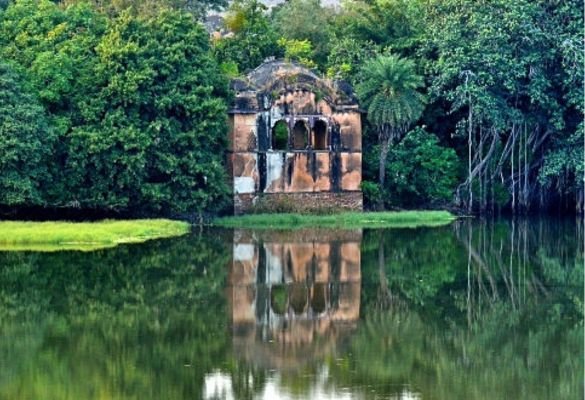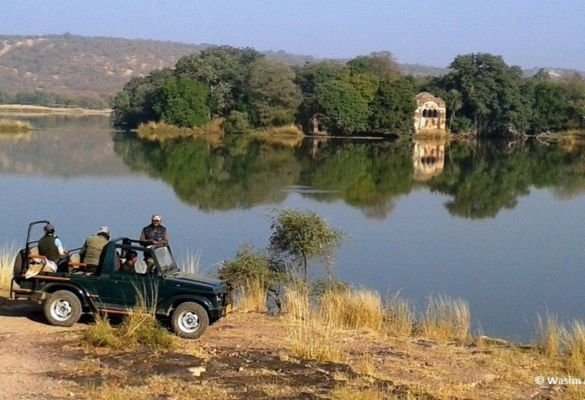Ranthambore National Park
Ranthambore National Park is situated about 13.5 kilometers from the city of Sawai Madhopur in Rajasthan, at the junction of the Aravali and Vindhya hill ranges. It is one of the best places to observe wildlife, especially as the animals here are accustomed to human presence. The park spans approximately 400 square kilometers, and when combined with the Sawai Man Singh Sanctuary, the total area is about 500 square kilometers.
Ranthambore National Park is filled with remnants of historical structures, offering glimpses into past eras. Numerous water bodies are scattered throughout the park, providing much-needed relief to the wildlife during the scorching summer days. Atop a hill stands the massive fort, from which the park gets its name. Scattered across the jungle are various ruins from bygone times, creating a unique blend of nature, history, and wildlife. The tigers in Ranthambore National Park are known to hunt even in full view of visitors, adding to the thrilling experience of exploring this diverse and captivating landscape.


Ranthambore Fort
Ranthambore Fort is a renowned ancient fort in India, recognized as a UNESCO World Heritage Site for its historical importance. It's situated within Ranthambore National Park, approximately 13 km from the Sawai Madhopur railway station. Constructed around 944 AD, this fort has played a significant role in the history of Rajasthan, serving as a symbol of the valor and pride of various Rajput rulers. It was strategically significant and thus came under the control of different rulers throughout its history. When India gained independence and the imperial era ended, the fort was part of the Jaipur Kingdom, with Ranthambore forest being an exclusive hunting area for the Jaipur royals.
Trinetra Ganesha Temple
The Ganesha temple at the entrance of Ranthambore Fort has been a significant site for Lord Ganesha's devotees since ancient times. It is the only temple in India dedicated to Trinetra Ganesha, featuring an idol of the deity along with his wives Riddhi and Siddhi, making it a unique representation of Lord Ganesha's complete family. The temple has several legends surrounding its establishment, which contribute to its popularity and distinctiveness among Hindu worshippers. One of the temple's unique customs is receiving postal invitations from devotees who wish to invite Lord Ganesha to their family's special events. Each day, the temple receives thousands of these invitation letters, all of which are read by the priest in front of the idol, reinforcing the temple's reputation as a significant religious site.


Jogi Mahal
Jogi Mahal, now a popular tourist spot within Ranthambore forest, was historically a resting place for the Jaipur Kingdom's royals during their hunting trips to Ranthambore. This charming palace, tucked away in the wilderness along the banks of Padam Lake, is an attractive site for those interested in historical monuments. Additionally, the massive banyan tree located near the palace, the second largest in India, serves as a significant draw for visitors.
Kachida Valley
Kachida Valley, situated on the outskirts of the tiger reserve zone, is a must-see destination for wildlife enthusiasts. This area is teeming with panthers, bears, and other wild creatures, set against a captivating landscape of steep outcrops, small valleys, low hills, ravines, and water bodies. The lush greenery and serene atmosphere create a sense of true wilderness, far from human activity. The only way to visit Kachida Valley is through the Jeep Safari Ranthambore, which allows you to explore the raw beauty and rich wildlife of this remarkable location.


Bakula Region
Bakula, regarded as the best spot for tiger sightings in Ranthambore forest, is a breathtaking area with dense greenery and abundant water bodies. The thick forest cover, along with numerous ponds and watering holes, creates a distinctive wilderness atmosphere. Because of its remote location, ample water sources, and rich vegetation, Bakula is home to a wide variety of wildlife, making it a haven for nature lovers. The chances of seeing tigers are particularly high in this region, with visitors often spotting tigers lounging or tigresses strolling with their cubs. These unique features make Bakula a popular destination for wildlife enthusiasts and photographers.
